|
|
|
Sort Order |
|
|
|
Items / Page
|
|
|
|
|
|
|
| Srl | Item |
| 1 |
ID:
169100


|
|
|
|
|
| Summary/Abstract |
Commenters often criticize the mass media for providing audiences a narrow and inaccurate representation of U.S. military veterans. This study examined the claim by researching how regional news publications in the 50 states represented veterans on Twitter. A quantitative content analysis documented the presence or absence of characteristics in 1,460 tweets that employed the terms veteran or veterans. Data were examined using cluster analysis. Three frames emerged. The most prevalent frame, labeled charity, highlighted instances in which veterans received assistance from charitable organizations and others. The second frame, hero, contained references to honor, World War II, and content that would elicit pride from audience members. The third frame, victim, highlighted the mistreatment of veterans by the military and/or society, mental health issues, politics, and the Gulf War. Results suggest U.S. news consumers are provided a narrow representation of what it means to be a veteran.
|
|
|
|
|
|
|
|
|
|
|
|
|
|
|
|
| 2 |
ID:
085422
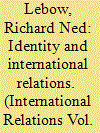

|
|
|
|
|
| Publication |
2008.
|
| Summary/Abstract |
Drawing on Kant and Hegel, debates in political theory and international relations generally assume that an identity cannot be created without the simultaneous creation and negative stereotypy of an `other'. Figures such as Schmitt and Huntington accept and even welcome this binary, while others, among them Nietzsche, Habermas and Rawls, look for ways of overcoming it. Drawing on Homer's Iliad and psychological research, I challenge the assumptions on which Kant and Hegel, and their successors, build their argument.
|
|
|
|
|
|
|
|
|
|
|
|
|
|
|
|
| 3 |
ID:
186851
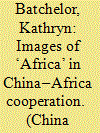

|
|
|
|
|
| Summary/Abstract |
The question of who represents Africa and how Africa is represented to global audiences continues to be hotly debated in academic publications and in the media. The majority of these discussions critique Western representations of Africa, or set up the West as the implied Other in debates over Africa’s right to self-representation. In recent years, however, Africa has found itself increasingly represented by the People’s Republic of China. This article examines the visual representations of ‘Africa’ that are used in promotional material produced by China in connection with official China–Africa cooperation. The article finds that one of the dominant stereotypes used by China is that of natural, ‘primitive’ Africa, a stereotype that has historically been strongly associated with the imperial gaze of the West. This is seen as potentially undermining key elements of China–Africa discourse, notably China’s emphasis on respect for its African partners. At the same time, the article highlights similarities between the imperial gaze and the tourist gaze, and considers the possibility that China’s representations of Africa might be compatible with a tourist gaze on Africa.
|
|
|
|
|
|
|
|
|
|
|
|
|
|
|
|
| 4 |
ID:
152486
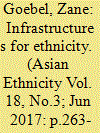

|
|
|
|
|
| Summary/Abstract |
Social categories need to be replicated to endure. Commentaries about social practices drive replication. Commentaries increase the number of signs emblematic of this category. In contemporary nation-states, mass education, bureaucratic processes, and mass media create large participation frameworks that facilitate replication. I term these participation frameworks ‘infrastructures for ethnicity’. This paper examines two types of infrastructures that have facilitated replication of emblems of ethnicity in Indonesia. My data is drawn from a soap opera, Internet commentaries about this soap, and news stories about clothing and culture. In looking at this data, I examine how old elements that point to ‘ethnicity’ are combined with new elements, how this new combination invites commentaries, how this process increases the semiotic density of these categories, and how all of this engenders diversity in Indonesia.
|
|
|
|
|
|
|
|
|
|
|
|
|
|
|
|
| 5 |
ID:
084959
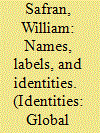

|
|
|
|
|
| Publication |
2008.
|
| Summary/Abstract |
This article addresses a relatively unexplored topic: the meaning and use of names and labels for ethnies and nations. It has been said (by Anthony Smith and others) that a nation is a "named" ethnic community. In the same sense, an ethnie is a "named" categoric group. The labeling of an ethnic or national categoric group by the group is often a self-conscious political act of identification reflecting its image and self-image and serving a variety of purposes: the achievement of collective self-respect, self-legitimation, adaptation and assimilation, differentiation, and self-exclusion, just as labeling by others is associated with legitimation or de-legitimation and positive or negative discrimination. The assigning of ethnonyms is a function of the sociopolitical context, ideology, and public policy.
|
|
|
|
|
|
|
|
|
|
|
|
|
|
|
|
| 6 |
ID:
152089
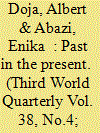

|
|
|
|
|
| Summary/Abstract |
In this article, we explore various forms of travel writing, media reporting, diplomatic record, policy-making, truth claims and expert accounts in which different narrative perspectives on the Balkan wars, both old (1912–1913) and new (1991–1999), have been most evident. We argue that the ways in which these perspectives are rooted in different temporalities and historicisations and have resulted in the construction of commonplace and time-worn representations. In practical terms, we take issue with several patterns of narratives that have led to the sensationalism of media industry and the essentialisation of collective memory. Taken together as a common feature of contemporary policy and analysis in the dominant international opinion, politics and scholarship, these narrative patterns show that historical knowledge is conveyed in ways that make present and represent the accounts of another past, and the ways in which beliefs collectively held by actors in international society are constructed as media events and public hegemonic representations. The aim is to show how certain moments of rupture are historicised, and subsequently used and misused to construct an anachronistic representation of Southeast Europe.
|
|
|
|
|
|
|
|
|
|
|
|
|
|
|
|
| 7 |
ID:
186340
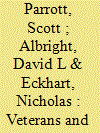

|
|
|
|
|
| Summary/Abstract |
The mass media are an important source of information concerning military service personnel and veterans. Veterans, veterans organizations, and others have criticized the mass media for providing the public shallow representations of veterans and military service in which veterans are heroes traumatized mentally and/or physically by their service. Despite the concern, scant research has empirically examined how exposure to such content affects public perceptions of veterans. Using an experiment, this study examined how exposure to news stories of military veterans informed thoughts, attitudes, and support intentions toward veterans. Results suggest short, one-time exposure to stereotypical news stories can lead readers to perceive an increased likelihood veterans will experience post-traumatic stress disorder and, in turn, feel less desire to be socially close with veterans. However, exposure to a story that challenges stereotypical representations of veterans appears to mitigate the effect. In addition, news exposure can influence support intentions related to veterans.
|
|
|
|
|
|
|
|
|
|
|
|
|
|
|
|
| 8 |
ID:
157079


|
|
|
|
|
| Summary/Abstract |
The visual image of Roma people in the media is mired in racialised notions of ‘the other’. Whilst we know what Roma stereotypes look like, there is little clarity as to how a ‘non-stereotypical’ image might be constructed. In order to examine the non-stereotypical, two sources of images are analysed: (1) entrants from an anti-stereotype Roma photography competition and (2) self-representations produced by Roma participants during ethnographic research. The findings show that if ‘Roma’ is foregrounded as the subject, even a non-stereotypical approach can reproduce ‘difference’ (from a supposed ‘norm’). ‘Roma’ is thus, at the moment, still strongly linked to a notion of ethnicity that is seen as different and racialised. However, when ethnicity is not emphasised, but rather self-representations and the ‘everyday’, such orthodoxies are challenged. These sources provide a unique opportunity to create a deeper understanding of ‘non-stereotypical’ images in order to challenge misrepresentations and racism.
|
|
|
|
|
|
|
|
|
|
|
|
|
|
|
|
|
|
|
|
|